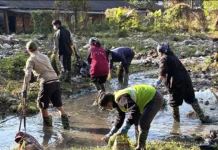[ Mary Gaduk ]
Lack of awareness on the importance of wildlife is the root cause and a challenge for natural resource conservation in Arunachal Pradesh. The world in which the concepts of conservation were developed is no longer the world we inhabit. Today, the world is running at faster speed, with new opportunities and new threats. Species conservation in this century is a mere statue because we are engulfed in the mouth of greediness for money and power. We need a new understanding, new science and new ways of communicating and acting as an agent for a conservation of this species in this new world. A changing world demands new approaches. Conservation of species is no longer as simple as removing human influences.
In my three months stay at Anini, Dibang Valley district during my Dissertation work, I encountered with much local expertise. There was a time when hunters used to go for seasonal hunting of musk deer; there used to be hundreds standing and the hunters would have to choose the healthiest male musk deer (Kastooree Hiran) because it carries pods. But now the tables have turned up and hunters have to use snare and trap, unlike past days.
This shows that the world in which we live today is not the same world anymore; something has changed and changed rapidly.
We still have a substantial amount of forest which is undisturbed but just empty forests. The reason is, animals in the wild have been killed off, eaten or sold out. Having walked in the wilderness for weeks not even a single animal has been sighted which raised many questions in my mind. Traditional hunting practices for bush meat consumption and agricultural practices like Jhum/slush burn culture pose greater threat to wildlife and poaching to some extent. Illegal-felling, over-exploitation, non-timber forests product extraction is the secondary problem.
There was a time when human interference was minimal. There were no protection or conservation problems and animal population was quite high. But with the development of the technological world and growing needs of the people, the number of wild animals became lesser; resulting is some animals going on the verge of extinction.
Our people are still engaged in the act of indiscriminately killing wild animals. Hunting of animals is not just cruelty done to a living creature but unknowingly putting ourselves into danger, the results of which will be faced by the coming generations. Killing animals create an imbalance in the ecosystem. The greatest disaster for wildlife conservation is the lack of knowledge, ignorance of people, unwillingness to learn of the impact, differences in setting up of an educational system and no proper functioning of the wildlife protection act.
We need to study and understand how things work in nature if we are to evolve a solution to the problems. Conservation education is a process of promoting awareness for the preservation of nature by using communication through interpretation in all forms to convey the desired message. Raising awareness through conservation education programmes, like distributing posters, stickers, animal printed T-shirts, cultural programmes and demonstrating video can increase participation by local people, foster positive attitude towards nature and promote natural resource conservation.
Moreover, information on the status of biodiversity, changing patterns and natural resources is very scarce and the current institutional arrangements for natural resource management are inadequate.
For future needs, the government should encourage growing youths to take a path in wildlife research-oriented jobs by providing funds to assess the current status of biodiversity of Arunachal Pradesh to merge with the changing climate, and find a way to bring out mitigation measures for better and healthy living for coming generations.
More protected areas should be establishment to provide ideal conditions for animals and wildlife laws should be enacted properly.
Let us pledge to conserve the beautiful and bountiful wildlife of Arunachal Pradesh for generations to see and feel the enchanting wilderness; let us not wipe it out. (The contributor is an MSc in Wildlife presently working on a project on Himalayan Goral at GRF, Darjeeling.)


